Crop diseases cause great harm, reducing harvest and its quality. In the Far East, where soybean has been cultivated for a long time and it occupies a large area, the pathogenic flora is very diverse. Soybeans are affected by fungal, viral and bacterial diseases [3].
Infected seeds have low germination and growing power, and are the primary sources of the spread of disease. Phytopathogens which are transmitted through seeds, are the first to enter sprouts and seedlings, causing either their death or inhibition of the growing processes and development of plants.
The most characteristic plants reaction to the disease manifests itself in the change of the enzyme activity controlling its metabolism, so biochemical parameters can be used to assess the condition of the plant. We have previously determined the activity of some enzymes in the soybean seeds affected by fungal and bacterial infection [10]. But electrophoretic spectra of enzymes were not studied. Physiological and biochemical processes in soybean sprouts grown from infected seeds were not enough studied. Therefore the aim of our investigation is to determine the effect of pathogens on the activity and electrophoretic spectrum of peroxidase, catalase and acid phosphatase in soybean seeds and sprouts grown from them.
Materials and methods of research
The subject of research carried out in 2009–2011, were the seeds of soybean of Sonata, Harmony and Dauria breeds grown in the experimental ground of the Far Eastern State Agrarian University (in village Gribskoe, Amur region). During the research most soybean seeds were infected with peronosporosis, fusarium and bacteriosis. In recent years purple cercosporosis, caused by the fungus Cercospora kikuchii T. Matsu et Tomoyasu has become widespread in soybean seeds of the Amur region.
Healthy seeds and sprouts grown from them were a control. Seeds were germinated in bibulous paper rolls in the laboratory. Seeds affected by fusarium decayed and did not germinate. The sprouts from seeds affected by peronosporosis and purple cercosporosis did not differ from healthy ones and showed no signs of disease. On the sprouts grown from the seeds affected by bacteriosis, signs of the disease were present.
Peroxidase activity was determined by Boyarkin method [2] using benzidine as a substrate. Catalase activity was determined by gasometric method which is based on defining the volume of oxygen eliminated after the addition of hydrogen peroxidase to the protein extract [5]. Determination of acid phosphatase activity was carried out by calorimetric method based on quantitative account of inorganic phosphorus produced by cleavage of organic phosphorus compounds under the action of this enzyme [5]. Protein determination was carried out by Lowry method [4]. Specific enzyme activity was expressed in units of activity per mg of protein.
Electrophoresis was carried out in polyacrylamide gel by Davis in the Safonovs modification [8]. Staining of zones with enzyme activity in gel was performed by corresponding histochemical methods.
Results of research and their discussion
Analysis of seeds showed that all the studied breeds of seeds have an infection that ranges from 2,40 % (Harmony) to 3,92 % (Dauria). Agents of peronosporosis and bacteriosis dominated on the seeds. Peronosporosis agent colonization ranged from 0,87 % (Harmony) to 3,06 % (Dauria). The worst bacteriosis affection was observed in Harmony breed (0,76 %).
The results of investigation showed that the specific activity of the studied enzymes differs in healthy soybean seeds from that one in the infected soybean seeds. Change of the enzyme activity in the infected plant tissues indicates homeostasis abnormality [9].
In soybean seeds infected with bacterial and fungal infections, the specific activity of peroxidase is lower than in healthy ones (table 1). According to the literature data [1, 7], a decrease of peroxidase activity is associated with changes in the level of redox processes of the infected seeds, the infection causes a decrease in metabolic activity and respiration intensity.
It should be noted that the peroxidase activity in the seeds of all breeds, affected by peronosporosis, decreases slightly. To the greatest extent the enzyme activity decreases in seeds infected with fusarium (in 2,3–4,7 times). Since peroxidase can serve as a criteria for assessing the sowing qualities of seeds, low enzyme activity shows a decline in the growing power and germination of seeds [6].
Infection of soybean seeds is accompanied by the loss of some of the multiple molecular forms of peroxidase or a change in their mobility. In healthy seeds of Sonata and Harmony breeds 5 forms, in Dauria – 6 forms of peroxidase are found. Significant changes in the synthesis of molecular forms are observed in seeds affected by bacteriosis and fusarium. In protein extracted from the seeds affected by fusarium the least amount of forms with peroxidase activity was detected. It is due to synthesis inhibition of the molecular forms with low and medium electrophoretic mobility. In seeds affected by peronosporosis the number of forms does not change, but their mobility increases, especially in Dauria breed (fig. 1, A).
From the data presented in table 1, it is clear that soybean sprouts peroxidase activity varies with regard to a control (healthy seeds sprouts). Apparently, under the influence of pathogens metabolism of not only infected seeds but of sprouts grown from them was damaged. Difference in reaction of sprouts of different soybean breeds to infection was observed. Increase in peroxidase activity in 1.3 times with regard to the control occurs in sprouts of Sonata breed, grown from the seeds infected with peronosporosis. In all sprouts of Dauria breed grown from infected seeds peroxidase activity is lower than in the control group. In Harmony breed sprouts peroxidase activity changes slightly under the influence of infection. According to the literature data stable enzymatic system is peculiar to resistant plants [9]. In sprouts of all breeds grown from the seeds affected by bacteriosis, enzyme activity decreases.
At an early stage sprouts grown from healthy seeds of different breeds of soybean two forms of peroxidase were revealed (fig. 2. A).
The number of molecular forms in sprouts of Sonata breed, grown from the seeds affected by peronosporosis does not differ from the control. In Harmony breed additional zone with Rf 0.57 in electrophoretic spectrum was detected. Healthy sprouts of a susceptible to peronosporosis Dauria breed grown from the seeds affected by peronosporosis, contain minor molecular forms with medium electrophoretic mobility. In the sprouts of all soybean breeds examined with the signs of bacteriosis, the number of molecular forms increases despite the decrease of peroxidase activity. Apparently, this is a result of conformational changes of the enzyme molecule.
In contrast to peroxidase activity of catalase in the seeds of Sonata breed affected by peronosporosis, fusarium and purple cercosporosis is in 1,6–2,4 times higher than in healthy ones. In the seeds of Harmony breed catalase activity increases in 1,5–1,8 times during the infection by bacteriosis, peronosporosis and fusarium and remains at the level of healthy ones in the seeds affected by purple cercosporosis. Infecting of Dauria breed seeds with peronosporosis and fusarium results in increase of catalase activity ~ 2 times (table 2).
Table 1
The specific activity of peroxidase in seeds (units/mg of protein), and soybean sprouts (units/mg of protein x 10-2)
|
Breed |
Control |
Diseases of the soybean |
|||
|
peronosporosis |
purple cercosporosis |
fusarium |
bacteriosis |
||
|
Seeds |
|||||
|
Sonata |
105 ± 13 |
96 ± 14 |
75 ± 2 |
46 ± 1 |
87 ± 15 |
|
Harmony |
114 ± 21 |
107 ± 21 |
61 ± 2 |
29 ± 2 |
95 ± 11 |
|
Dauria |
127 ± 4 |
115 ± 29 |
89 ± 4 |
27 ± 1 |
106 ± 11 |
|
Sprouts |
|||||
|
Sonata |
34 ± 7 |
44 ± 3 |
33 ± 2 |
– |
29 ± 1 |
|
Harmony |
18 ± 2 |
21 ± 3 |
18 ± 1 |
– |
14 ± 2 |
|
Dauria |
12 ± 2 |
8 ± 0,5 |
7 ± 1 |
– |
6 ± 1 |
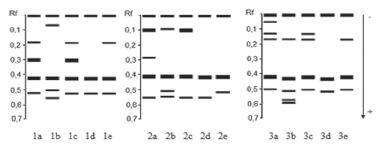
A
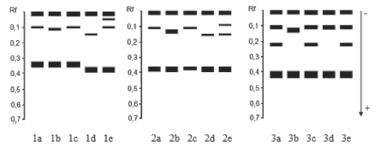
B
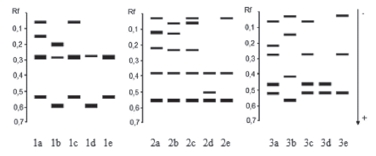
C
Fig. 1. Electrophoretic peroxidase spectra (A), catalase (B), acid phosphatase (C) in the seeds of soybean breeds: 1 – Sonata, 2 – Harmony 3 – Dauria; a – healthy, affected: b – peronosporosis, c – purple cercosporosis, d – fusarium, e – bacteriosis
Table 2
Specific activity of catalase in seeds (units/mg of protein x 10-4), and soybean sprouts (units/mg of protein x 10-3)
|
Breed |
Control |
Diseases of the soybean |
|||
|
peronosporosis |
purple cercosporosis |
fusarium |
bacteriosis |
||
|
Seeds |
|||||
|
Sonata |
54 ± 2 |
89 ± 3 |
127 ± 13 |
130 ± 34 |
125 ± 6 |
|
Harmony |
62 ± 2 |
110 ± 15 |
70 ± 10 |
110 ± 12 |
95 ± 8 |
|
Dauria |
49 ± 1 |
90 ± 8 |
69 ± 8 |
96 ± 19 |
68 ± 3 |
|
Sprouts |
|||||
|
Sonata |
84 ± 5 |
119 ± 7 |
78 ± 5 |
– |
76 ± 5 |
|
Harmony |
75 ± 3 |
85 ± 3 |
68 ± 3 |
– |
57 ± 2 |
|
Dauria |
80 ± 3 |
90 ± 2 |
75 ± 3 |
– |
69 ± 2 |
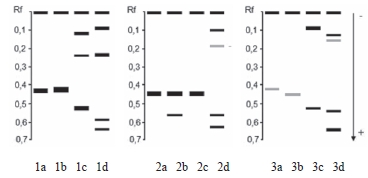
A
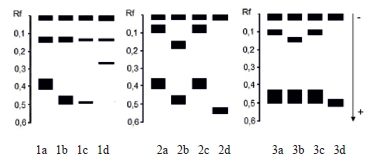
B
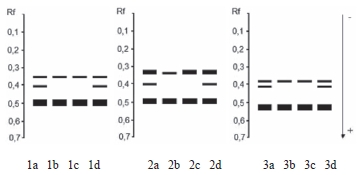
C
Fig. 2. Electrophoretic peroxidase spectra (A), catalase (B), acid phosphatase (C) in sprouts of soybean breeds: 1 – Sonata, 2 – Harmony 3 – Dauria; a – healthy, of infected seeds: b – peronosporosis, c – purple cercosporosis, d – bacteriosis
Despite the increase in catalase activity in seeds, affected by fungal infection, the number of multiple molecular forms remains at the control level or reduces, and only in bacterial infection occurrence of additional forms with Rf 0.07 and 0.09 in Sonata and Harmony breeds, respectively was marked (fig. 1. B).
Catalase activity in soybean sprouts grown from affected seeds depends on the type of the infectious agent (table 2). In the seeds affected by peronosporosis and in sprouts grown from them, the highest catalase activity is marked. In sprouts affected by bacteriosis activity decline is observed, the number of molecular forms decreases (fig. 2. B).
Table 3
The specific activity of acid phosphatase in seeds (units/mg of protein х 10-6), and soybean sprouts (units/mg of protein x 10-5)
|
Breed |
Control |
Diseases of the soybean |
|||
|
peronosporosis |
purple cercosporosis |
fusarium |
bacteriosis |
||
|
Seeds |
|||||
|
Sonata |
17 ± 0,5 |
22 ± 1 |
14 ± 1 |
5 ± 0,3 |
15 ± 0,5 |
|
Harmony |
23 ± 4 |
31 ± 2 |
17 ± 1 |
8 ± 0,3 |
15 ± 0,5 |
|
Dauria |
20 ± 2 |
27 ± 1 |
19 ± 4 |
7 ± 0,2 |
16 ± 3 |
|
Sprouts |
|||||
|
Sonata |
15 ± 2 |
9 ± 0,3 |
12 ± 4 |
– |
11 ± 6 |
|
Harmony |
7 ± 0,1 |
4 ± 0,1 |
8 ± 0,2 |
– |
7 ± 0,1 |
|
Dauria |
11 ± 3 |
5 ± 0,1 |
12 ± 3 |
– |
12 ± 2 |
Acid phosphatase activity in the infected seeds both increases and decreases in comparison with the control (table 3). Significant reduction of the enzyme activity (~ 3 times) was found in soybean seeds affected by fusarium.
Electrophoretic studies have shown that a different number of acid phosphatase forms was found in infected seeds as compared with the healthy ones (fig. 1. С). The seeds infected with fusarium and bacteriosis agents contain the fewest enzyme forms. Qualitative and quantitative changes in enzyme activity is likely to be connected with malfunction of carbohydrate and lipid metabolism, which occurs under the influence of infection.
In sprouts of Sonata,Harmony and Dauria breeds, grown from the seeds affected by purple cercosporosis and bacteriosis, acid phosphatase activity remains at the level of control. Significant reduction of acid phosphatase activity (in 1,7–2,1 times) is observed in soybean sprouts grown from the seeds infected with peronosporosis (table 3).
In healthy sprouts of all examined breeds 3 molecular forms of acid phosphatase were revealed. The same number was found in sprouts affected by bacteriosis. In sprouts grown from the seeds infected with peronosporosis and purple cercosporosis zone with Rf 0.41 disappears (fig. 2, С).
Conclusion
Thus, quantitative and qualitative changes of enzymes in the affected seeds and sprouts, grown from them, depended on the soybean breed and the type of infectious agents. However, the general trend in enzyme activity was detected: the specific activity of peroxidase in seeds of all soybean breeds studied decreases under the influence of different infection while specific activity of catalase rises. Fusarium infection of the seeds results in a sharp decrease of acid phosphatase activity. Bacteriosis agent action reduces catalase and peroxidase activity in sprouts of soybean, but the heterogeneity of peroxidases increases and of catalase decreases, and does not affect the acid phosphatase spectrum.

